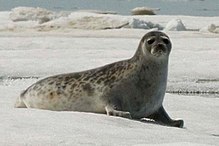| Arctic ringed seal | |
|---|---|

| |
| Scientific classification | |
| Domain: | Eukaryota |
| Kingdom: | Animalia |
| Phylum: | Chordata |
| Class: | Mammalia |
| Order: | Carnivora |
| Clade: | Pinnipedia |
| Family: | Phocidae |
| Genus: | Pusa |
| Species: | |
| Subspecies: | P. h. hispida
|
| Trinomial name | |
| Pusa hispida hispida (Schreber, 1775)
| |
The Arctic ringed seal (Pusa hispida hispida) is a subspecies of ringed seals (Pusa hispida). Arctic ringed seals inhabit the Arctic Ocean, and are the most abundant and wide-ranging seal in the Northern Hemisphere. The ringed seal species is the smallest true seal, and gets its name from a distinctive patterning of light spots on dark grey colored fur. The ringed seal is commonly preyed upon by Polar bears, Arctic foxes, and Killer whales. Population estimates and survival rates are unknown, but average life expectancy is 15-28 years. Ringed seals have long been a component of the diet of indigenous people of the Arctic. Arctic ringed seals have been listed as threatened on the Endangered Species Act since 2012, and increasingly face loss of their habitat due to shrinking ice and snow cover.
